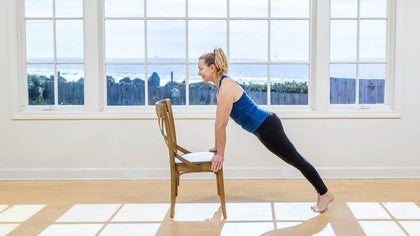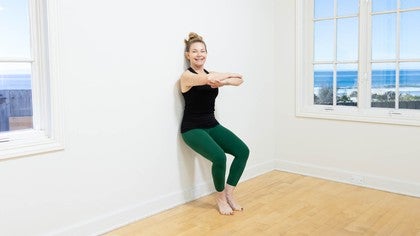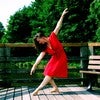Description
About This Video
Transcript
Read Full Transcript
All right, we're going to get started. And I want everyone to have your seated chair here, technically with no arms on it, if you can find that, and then a dowel or a broom stick or a mop handle, something that resembles something like this. So let's put that down. We won't need that for a while, but as we get seated, let's just get cozy at the very front of your chair, everyone. And I want you right at the very front, so you can locate easily the bottom of your pelvis, your sit bones.
And I like to just kind of rock side to side. It's very easy to fuel those bony landmarks. And then you'll just pause and sit in place. And then take your feet and your legs in line with your hip bones. We're in our parallel.
So this class is just playful. You're gonna feel your abdominals. You're going definitely gonna feel the work and control around here, some stretch in your back, some spinal mechanics of bending and rotation and some creative playful ways, which I try to often offer. But first, let's take some breathing. So I want everyone to put their hands on their ribs and visualize that musical instrument, the accordion that opens and closes.
And so as we take a large inhale, we're trying to spread those ribs side to side and back. And then as you exhale, a little release of that. You don't have to push hard with your hand. Just feel the air change, the volume change. So we inhale, growing a little bigger through the ribcage, and the exhale might get a little bit narrower here.
Just feel some breath. And as you're taking your breathing here, anchoring down into your sitting bones, down into the feet. Let's take one more. And just exhale. Now let's take our hands.
Feel the pelvis right here, the bumpy bones in the front, those bumpy bones and your pubic bone, right? It forms this triangle, hip, hip, pubic bone, can kind of visualize that. If you want to, please put the heels of your hands on your hip bones and your fingertips near the pubic bone. You're angling that. So you have that reference.
Now, as you stay even on your sit bones, I want us to feel some deep engagement of the abdominals and down into the hips a little bit. Take one foot and just lighten your footprint. We're not really lifting the foot yet. Just lighten your foot print and what we're trying to do here, we're just keep alternating. Yeah hopefully, you'll see me change my feet a little bit, but what I want us to feel is that we can start this very basic lifting of a foot or leg and keeping this access of length and centering, if you will, like a big stack of containers.
And then we don't shift our ribcage, our head or our neck. You might feel a little weight change on your sit bones, minuscule little weight shift. You know this is like prepping us for walking and doing bigger skills of lifting legs, which that comes at the very end of class. But right now, as you can see, I'm starting to make the movement bigger. And I'm controlling how my weight is on my sit bones.
Starting to feel the muscles around this lower abdomen, the ribs, obliques, back muscles. You might like this hand position. One hand, one hand is on your low back. And those spaces are in toward each other and up. So let's just do maybe four more right now.
And so you're very vertically oriented in your sitting position. Now, of course, you're going to feel some muscles engage and activate right here in your hip. That's good. We want some strength, but we also want that strength more on the interior kind of part of your hip joint. Should we try a few more like that?
It might help to bring your legs a little closer together. And this takes practice. This takes practice to lift a leg. It looks easy probably, but it's not that easy to stay sitting tall, lifting a leg up. And if this is easy for you right now, fantastic.
Everything doesn't have to be so incredibly challenging. But I think you're starting to feel this, right? So in together and up. Now, we're gonna move this angle, the pelvic triangle. And for this, I'm just gonna have you all stay seated on the front of your chair there, and you can take your fingertips to the top hip bones, breathe in.
Now, when we blow out the air, take these hips and really tilt back that way to the chair. Underneath your sit bones are gonna roll underneath a little bit and then just bring yourself right back up. I want you just to do three or four. So now we are shifting the way intentionally off the sit bones from vertical and then back. So when we tilt back, that lift happens before we move, and we lift before we move.
Again, one more time. Lift and move and think of lifting and moving. We're gonna make that movement bigger now and go back. So here we go. You can put your hands here, everybody, or here.
I'm gonna just hold that chair and just take yourself back and get a little cozy. So here's the position we're gonna be in here for a bit and what I want you to work on. And maybe this will help. If you put your hands on your lower abdomen inside the pelvic triangle there, can you bring your stomach in away from your hands a little bit? And notice that this part of your back there's negative space here.
That's okay. That's gonna be there. But underneath here, the muscles of the buttocks down into the hamstrings, your sit bones that we were sitting on a minute ago are now angled down the back of your leg. I think that's pretty easy to see. I have this pelvis in this rotation, this backward rotation.
Okay, take a breath. Let's do the footprint lift. So see if you can just lift the weight of a footprint and keep all of this in. Do your best, not to pop out your tummy or push your tummy out. Stay in control of this area, not wiggling a lot.
So what would be wiggling could be something like that. So exhale, inhale, and exhale. Now, of course we are human beings. So we do have a little movement relative to other movement. You can't be completely frozen and not moving at all.
Not really possible, but we're working towards control, one of the principles of Pilates that's really throughout, right? Control, strength control. Start to make that leg gesture a little bit bigger, everybody. (coach exhaling) We're gonna get real charged up here and try to get the leg very close to the chest without protruding this area outward and keeping your pelvis in that tilt, hip bones to the back of the chair. Let's take four more.
Now, if you're slipping on your chair a little bit, maybe you squeeze your bottom, might keep you kind of held them in place. Or put something I'm gonna, I'm slipping a little bit, but that's okay. You can also put sticky grip, but let's don't worry about it. We're gonna bring a leg in. Now, as you bring this leg in, let's move our hands and put them actually behind your thigh.
So here we are. This could feel like a resting position. We're not resting. We're still tilting that pelvis back. I want you to press your thigh onto your hands, And as if you're gonna sit your chest up off of the chair, I don't want you to sit up.
It's the act as if I'm as if I'm gonna sit up. So that gets me going in my upper abdominal. How about you? Can you all lower your shoulders a little bit? Press your thigh into your hands.
And maybe you get a little lighter off of your back, off the chair. Some of you might be feeling a lot going on here. That's so good. There's a relationship in there. Lower the leg.
Keep the pelvis in control. Try to keep your hips pulled back. Breathe, let's do the other side. Hands behind your thigh. And you're pressing your leg, actively pressing your leg into your hands.
You can relax your foot and shin. Now it's as if you're gonna sit up. You're trying to sit up out of the chair, not with your head, but with your spine trying to bend more forward. I've put us in this position on purpose. So we don't really move much.
We're acting as if we're moving. We're moving. If you were on the floor doing this, you'd be doing a lot of upper abdominal activation, doing a lot here, too. Let's go one more. Pressing the hamstring so there's a little bit of rocking.
That's starting to occur. Now let's go this way, guys. Take your foot down. Keep your tummy in control. Maybe just hands out like this.
We'll do four on an exhale. Lift your leg and lower. Keep this tilted back. Exhale, your pelvis tilted under and lower. But pull this area inward upward.
Some of you're probably noticing I'm getting my leg higher. That's a good thing. I like that. Bring this up here and place your hands on the shin. Hands on your shin. The outside hand, put it down by the heel.
This inside hand more by the knee. And I want you to just do what I'm doing. You're kind of wiggling your shin. What we're looking for precision-wise and control is that you heel is in line with the back of this hip. So you can use those hand partly as little steering wheels there.
But how about bending it and really bringing the heel toward the back of that thigh. Use your hands, press against you. Use some muscles in your arms. Use your upper tummy. Try to sit forward.
How's that feel? We're gonna change legs. Keep your arms kind of at the ready. Turn the hands to the other side and you pick up the other leg. Outside hand goes low.
Watch where you put that heel right in line with your sit bone, and you pull it in. Bring your heel toward your buttocks, your chest toward your thigh. Tilt the pelvis under. So we're gonna change sides. Take a breath, let go.
Put it down and pick up the first leg. And you're just gonna do little pulse pulse, one, two, and change. And one, two, and change. Control that pelvis. Try not to wiggle it around much.
Four more, go a little bit quicker. We've got a one-two and a one-two and a one-two. Good, and a one-two. And then just place your foot down. Just hold for a moment and then bring one leg up and then the other leg.
So just for a moment here. I'm slipping, just a tad, I just want to get. I want us to have our hands low on our shins, rest for a second. But now pull out your hands on your shins. Try to get your chest more toward your thighs.
Could you start attempting a little rocking movement? I'm attempting, but I'm not getting very far. My back is really not leaving the chair and I did this on purpose. I want to prepare for when I do roll. I'm getting those muscles in the ready.
One more like that. Now I'd love, if you could keep your feet up. If you need to rest, please put the legs down, but maintain that curve. We're gonna work our arm position a little bit. So I want you to take both arms slightly up on a diagonal.
I have my shoulders right against the side of the arms of the chair, the back of the chair. Open and press on your shins. So we do a lift and open and a press on the shins. Now, if you don't let like the legs up or you need a little break, it looks like this. You still have that form that we're working on and your arms come up, open and, so you're kind of pretend that you're hugging onto your shins, you're pulling into your stomach.
Good and in, one more time like that. Up, open and in. Put your hands here, everybody just round forward, and then come up to sitting tall for just a minute. How do you feel there? Feel some stretch probably in your back, some activation in your tummy.
This is good. Now we're gonna be moving on to do some articulation and bigger motion. So what I want you to do here is have a corner sit and set up. So I've got the corner of the chair here. Legs are just apart and I'm easily in position, again, you feel those sitting bones.
But because that last series was really about the round shape, get in this. Let's oppose that. And now take these two hips and really arch them forward and arch your chest forward and arch your shoulders back or bring your shoulders back and look up. Now, it's pretty exaggerated on purpose. Now keep going, keep going.
I want you to look. I'm sticking my chair out, my chest. I'm sticking my tushy out, that's okay. Go all the way down. Let your hands drop and then roll yourself up from your low back.
There's that shape you were just in a minute ago. Right back up to sitting tall. Twice more. So we're getting some different mobilization of the spine. This is extension, big arch of your spine.
And then when you come up, it's that round flexion. Get on those sitting bones and just build that spine very, very tall. A couple more, and you arch. Chest goes out and up. Tail goes back and out.
Use your back to stretch your chest forward. Drop the hands, roll yourself up. Let's go one more time. You can look up even. Tailbone is back, sitting bones are back.
More weight is on the pubic bone and you're going all the way down. Drop the hands and roll all the way up. Some big spinal mobility. I think that feels really good after doing more of those rounded shapes. Time for the dowel, so go ahead and grab that.
And I'm having us use this dowel, everybody for a little assist and a teaching tool for a way to decompress your spine. We've been decompressing. This is a little bit different. And let's go this way. Angle your feet flat, dowel right in between.
My legs are apart. I'm just back on this sit bones. And then what I need you to do is just stack your hands about chest level, not too high. Doesn't matter which is on top because you'll switch it. But here's the deal.
We push this down into the ground and the push down, I want us then to lift up. I'm almost unweighting my sit bones off the chair. I'm not standing up yet. I'm activating the base of me and trying to sit up. I am pushing my feet into the floor a little bit.
So you can see it here. Now if I let go of that work, you'll see it. Probably a big change. How it kind of settle in. So let's do this.
You push down, root your feet, grow the spine. So if we were outside on the sand, this would be like the umbrella stick going into the sand and then I'd be going taller, taller, taller, and I am going taller. And then release, a couple more. You can change hands on top. Ready?
Feet press. Press the stick into the ground. You're pressing it down. You're bringing your shoulders low and trying to sit almost taller than your dowel here. Lift up.
You're trying to take some pressure out of the discs of your spine. Feel the muscles engaged in doing that and then release and then press down and lift. Pilates is not just about the abdominals. You know that we do a lot there, but a lot is about our back muscles, spine muscles. So right now you're deeply working like these intervertebral muscles in your spine.
Now everybody stay there. You're tall, right? You're really tall. Try that round shape here. So if I bring my waistline back, away from the stick, I'm still decompressing and I'm round.
Now, let's move through the extension just a little bit. Keep pushing this down. Use your feet into the floor, lift your chest. Some of you can go further than I am and that's okay. I'm gonna show you, you can go a little bit further, right?
Let's mobilize that spine so you can start to make it a little bit bigger. And just move, a couple more. So I'm bringing that stick down into the ground, pressing my feet. Let's take one more and enjoy that flexion and enjoy your extension. And then just settle into a normal sit and just feel the difference in that versus how active you were just a minute ago.
Pretty interesting, right? Who felt something here? Anybody? That's cool if you did. Now we're going to work on some rotation of spine and bending sideways of the spine.
So I want you to take your dowel. You're sitting, feet flat, still at the front edge and then lots of places we can measure where this dowel's going to go. You could have it from your pelvis on that diagonal. That spheres feels fairly natural for my shoulder here. It's called scaption.
It's a natural line that your shoulder blade, how it organizes on your back ribs. Some of your natural position is a little more open. Some of you is more in front. You'll know. So just kind of do this back and forth a couple times.
It's a little vague I realize. But hopefully it feels pretty natural. You're like, yeah that's where it goes. So you just keep it there. Take the other hand.
And just for today, put your hand on your shoulder. Get up on the sitting bones and let's feel that decompressed quality, again. So you push this down and lift up. Let's take an inhale. Now I want us to turn our chest, not the belly button, the chest toward the arm with the dowel.
So it's not a big rotation. I don't want you to take your belly button in your hips, just your ribcage spine, and then extend your arm forward, palm up. Return your hand to your shoulder and then rotate back to your start position. But now then go away from your stick. Turn your chest spine, not your belly button and then take your arm behind you.
Palm face down. You're reaching in your backseat for your keys or something. Turn again, so you're turning toward the stick, chest spine reaching in front, waiting for someone to give you a high five. And you rotate and you're away. You decompress the whole time.
You decompress the entire time, extend the arm, turn your palm face down. Let's just do it one more time, everybody. Decompress, push your feet into the floor. Lift, rotate, through your chest spine. Extend, open your hand, fingertips at shoulder, return, turning away from the dowel.
And you can look with that hand. You can see and turn with your neck also, and then just relax for a second. Feel the difference between active and non. Next physician is lateral flexion, or next exercise. Now I want you to move the stick more almost directly off the side of your hip.
Same hand here or behind your head. This feels kind of nice. Decompress, breathe, side bend. This is nice. It's a yawn kind of thing.
You're opening the ribs, lifting the elbow and under arm up, pressing this down. And then just return to sitting tall, decompress. Let's inhale and exhale as you go to the side. Now I'm doing my best to keep the sit bones on the chair. But again, we're human.
We're not perfect. There's gonna be a little lift on this one, just a sneak of a lift. That's okay for today, right? Yeah, open, open, open, open, open, should feel pretty good. And then come all the way up and lower.
Now we've got one more rotation. Then we have all that on the other side. Take this down now a little bit more on the back diagonal. Before we go rotating the ribs with this, you'll know right away if this doesn't feel good in your shoulder. You'll just, right now I've said, I don't think that feels good.
Two options. Don't do this part. Three options. Don't do it. Bring it in closer or keep it back and lower your hand, just some prerequisites for your shoulder.
I'm going back here. Now what I'd like to do first is turn my chest toward the dowel. The dowel is moving behind me a little bit. Now I'm offering the front arm like I did before with the palm face up, stretch your arms in opposite directions. You're decompressing.
And then you're coming back to home. Twice more. So decompress, lift, rotate. The dowel moves back behind us a little bit. We offer and then we come back.
I don't know what you're offering someone, but returning, ready? Rotation, press into the floor. Keeping your weight even on your sit bones relatively, even on the feet and then come back and rest. And then just rest. Just feel the rest for a second.
Lot of work in the shoulder, in the arm and your back, and probably around your abdominals. Trunk. All right, so same set up other side. Find your angle where your shoulder blade just easily rests on your back ribs, not up, not down, too far. You don't have to tug it down.
It's just there. That's your general line for a lot of arm extra exercises. But for right now, we're gonna do here. Press down on the dowel so that you decompress and lift taller. Breathe in.
Let's rotate toward the dowel through your chest. Arm forward, offer something. Maybe you get a little, you know, high five, hand back and you turn, now we turn away from the dowel. Turn away from the dowel. You can look open your arm and turn your palm face down.
That's you reaching behind to pick something up, come back to facing front. Relax, decompress, breathe in. Turn, offer. Stay decompressed in these rotational movements. There's less pressure in those discs.
When we're decompressed, rotate the chest. You can look, palm goes face down and then one more time through. Ready? Decompress and rotate. So the rotations, everybody, don't have to be too big.
Trying to keep that pelvis relatively facing front, that triangle angle. You're really turning through your thoracic spine, the ribcage part of your spine. And then just relax. Side bending is next, so arm goes to the side. We did our hand behind our head.
Before we bend, we want decompression. So we lift and inhale, anchor the feet and bend your trunk, bend your spine. You're opening the ribs to the side. I'd like to think under arm goes up to elbow, open the ribs and then come back to center, relax a little bit. Inhale, decompress and up and over.
Pilates is so healthy for these strength and length moments, right? Everything has a strength component. Everything has a length component. Every exercise, every single one, we never compress. We never collapse.
We're always looking for that height and that lift. It's healthy, safe also, arm behind, back to this one. So this last rotation we're turning toward the dowel-ish with our chest. Front arm comes forward and we offer, and then we return. Now remember that story about your shoulder.
If this feels icky, you just either lower it or bend it or just, you don't even have to do this part. But I want you to feel the muscles of your back, helping you with this rotation, right? One more time. Decompress just through the chest. How the muscles of the back and the spine?
Not just your abdominals, yes, the abdominals, too. All right, and everybody rests. Just feel the difference in that, a lot of back work, right? Let's do one shape that just bends us forward for a second. Just bend forward, just wiggle, wiggle, wiggle.
Relax your back. That's a lot of vertical and a lot of rotation, but we still have some really yummy things to do. We're about to do some planking, huh? But before we plank, let's warm up our wrists. So just hold your dowel.
Sit with some decompressive quality and just roll this dowel. Now I love to feel the pinky finger part of my palm really on the bar or the dowel, not rotating inward there. So if I get the pinky finger on, it sets those shoulders in a much better environment for weight bearing. We could do a lot more with this wrist stuff today. We're just gonna do roll and roll a couple more times, and then find a nice line of neutrality in your wrist.
You're not up down. You're just nice and flat. Then bend the elbows, bring the dowel to your chest, bring it away and do that a few times to your chest and away and to your chest and away. And one more time, to your chest and away. Now we're gonna do a little rowing motion down to your legs, up your body and forward.
What I want is to feel with this lots of things, decompress spine, pinky finger part of palm on the bar. A little bit of pulling out with the hands. And what else? Yeah, a smile on your face. Ready?
Reverse it four times. It's a lot. So weight bearing, planking. We're gonna need our shoulder grille environment nice and ready to hold part of your body weight up. One more.
That's it with the dowel. All right, for today, let's stand up. Put your dowel away and then we're gonna do plank with the chair. I'm gonna turn this, everybody. Now plank with the chair, two things.
You could have your hands directly facing in. I tend to choose hands a little bit wrapped open like this, and then I want you to step back with one foot and then the other foot. Now we haven't really done straight leg things in this class yet, except for that seated at the beginning. So let's just hold our body position and what I want us to feel here are lots of things. Legs squeeze together.
Those abdominals active, that decompressive quality that you've been working on here. Shoulders that are low off the ears. And just hold that. Now, come on in, just put a foot down and rest for just a second. My chair is very hard.
So yeah, there's a lot of weight on the wrist, but planks, you have weight on your wrist. Again, same thing. Stepping back, set those shoulders first. Just step right to it. So you can stay here.
This is great. You don't have to do pushups or anything else, but I am gonna have this add leg lifting. Like we did earlier, lift a leg without wiggling those hips. Remember what I said though? We're not robots.
There's gonna be relative movement in this body, but we can control around that pelvis. How is working with that decompress spine? And how much work is going on in the body with this what seems like a simple little thing? Rest for a second. We'll do one more round.
You can either plank or slow marching or come with me. I'm gonna do a little run, little mountain climber kind of thing. So I'm whole my body line, setting things up and then I'm just going to pick up my tempo. Try your best not to wiggle too much. Basically stay in the lane with your chair.
Let's count it down. 10, nine, four, three, two, one, plank it. Hold, hold, hold. And then step in and rest. Oh my gosh, you guys, stand up.
Can you imagine doing that on your 30-minute break at work or something? Just stand here and just roll your shoulders. Roll your shoulders. We did a lot of work today. I hope you feel good.
I hope you feel like that was some new information for your body and that you learned a little bit about some spinal mechanics.
Active Aging: Active Aging with Amy Havens
Comments
You need to be a subscriber to post a comment.
Please Log In or Create an Account to start your free trial.













